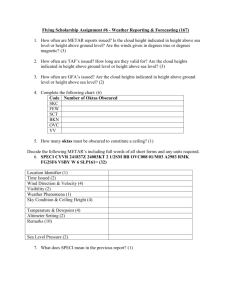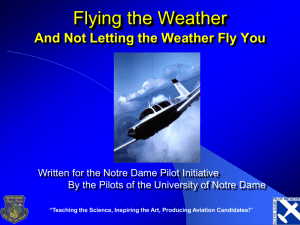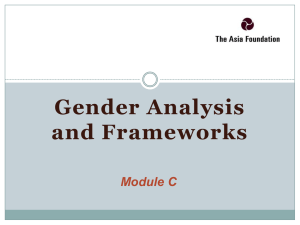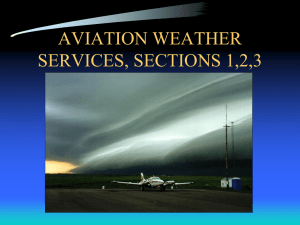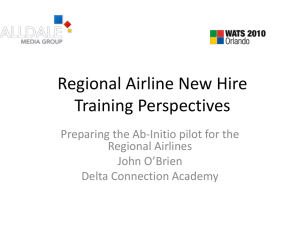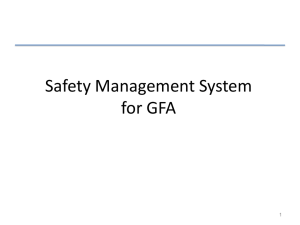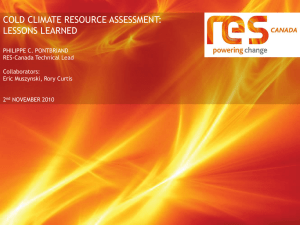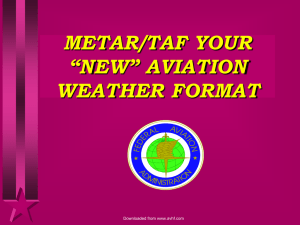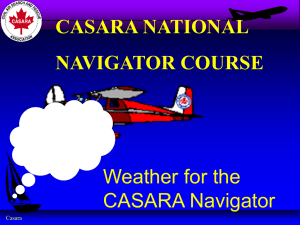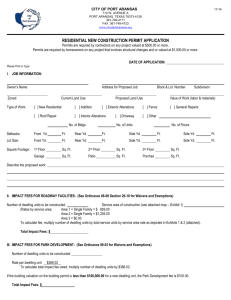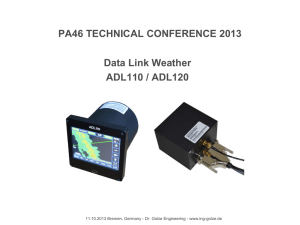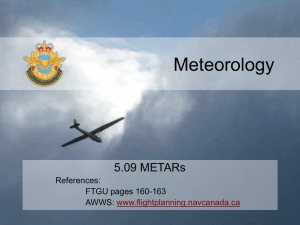Meteorology 3
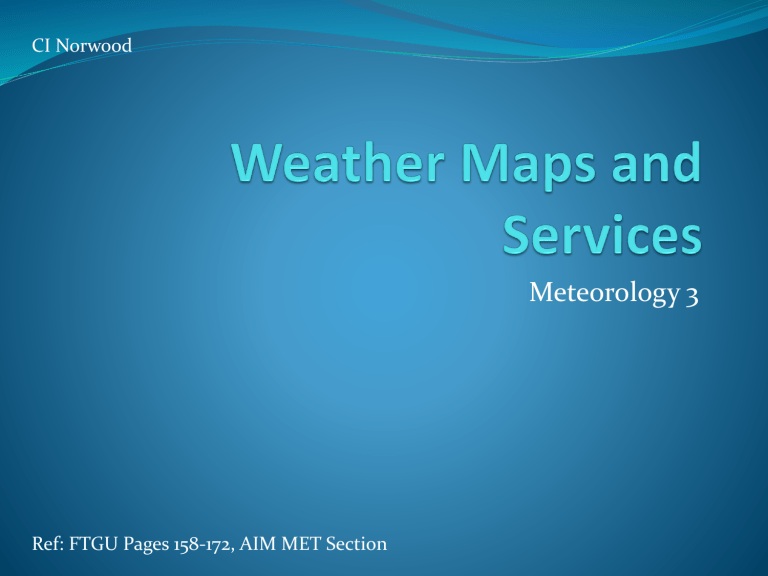
CI Norwood
Ref: FTGU Pages 158-172, AIM MET Section
Meteorology 3
Review
1.
What are the four air masses that affect Canada?
2.
What is a Front?
3.
What does a thunderstorm need in order to form?
Topics to be covered
Weather services and maps
How to read:
Surface/Upper level/Prog charts
METARs/TAFs
GFAs/FDs
Need to know this as interpretation of weather is crucial to aircraft safety.
Aviation Weather Information
Service (AWIS)
NavCanada FSS system
Provides weather information to help pilots before and during flight
Service puts pilots in contact with specialists who help pilots make educated decisions and calculations based on factors relating to weather conditions
Aviation Weather Briefing Service
(AWBS)
Fully interpretive weather briefing service available from the Flight Information Centers (FIC)
Access through toll free number
Equipped with complete set of weather products, including satellite and radar imagery
Specialists trained to interpret the weather data for the needs of users in aviation industry, as well as offer advice on particular weather situations
Documents for long distance flight available on request
Flight Service Stations (FSS)
Staffed by flight information specialists
Situated at various aerodromes across Canada
Services offered:
Enroute Flight Information Service (FISE)
Flight Planning Service
Surface weather observation service
Aviation Weather Information Service (AWIS)
Aviation Weather Briefing Service (AWBS)
VFR Alerting Service
NOTAM service
PIREPs
Pilot’s Automatic Telephone Weather
Answering Service (PATWAS)
Continuous recording of certain local weather information intended for aviation is issued by some
FSS and is available by telephone
Include:
Issuing station name and introduction, Instructions
SIGMETs, AIRMETs, METAR and SPECI
TAF and FDs
Freezing level, icing and turbulence
PIREPs
Times of sun-rise and sun-set
Significant Meteorological
Advisories (SIGMET)
Short term alerts to aircraft in flight concerning potentially hazardous weather conditions
Issued for the following phenomenon:
Active thunderstorm cells
Squall lines
Severe hail
Severe turbulence
Severe icing
Significant mountain wave effects
Hurricanes
Far-reaching sand or dust storms
Volcanic ash
Low-level wind shear
Automated Terminal Information
Service (ATIS)
Continuous broadcast of recorded non-control information at busier airports
Essential information:
Weather information
Active runways
Available IFR approach
NOTAMs, etc.
Pilots listen to ATIS prior to contacting control unit
Reduce controller’s workload and relieve frequency congestion
Updated every hour or when necessary
Comes with a letter designator to ensure most current version is in use
High Altitude SIGWX Charts
Shows SIGWX for a specific flight range:
Icing, turbulence and convective activity
Flight between FL250-FL630 (380-75 hPa)
Valid at 0000, 0600, 1200, 1800 UTC
Issued by the National Weather Service of the United
States government; the equivalent of the Canadian
Weather Service
Mid-level SIGWX Charts
Shows SIGWX for a specific flight range:
Icing, turbulence and convective activity
Flight between FL100 – FL240 (700-400 hPa)
Valid at 0000, 0600, 1200, 1800 UTC
Issued by the Canadian meteorological centre of
Environment Canada
Based on information collected from all the aviation weather forecast centers of the country
Surface Weather Charts
Graphical depiction of:
MSL pressure patterns
Surface location of fronts
Surface precipitation and obscurations to vision
Pressure patterns can be considered accurate up to
3,000 feet
Observed every six hours, issued 2 to 3 hours after observation
Upper Level Analysis Charts
Computer generated graphical depiction of reported atmospheric conditions at the pressure level, which include:
Wind speed and direction
Temperature
Moisture content
Frontal surface locations
Measured twice a day, at 0000Z and 1200Z
Issued for 850 mb (5,000’), 700 mb (10,000’), 500 mb
(18,000’) and 250 mb (34,000’)
Upper Level Analysis Charts
Height: Contours represent the height of the pressure level in decameters, spaced 60 m apart on except on
250 mb charts where it’s spaced 120 m
Temperature: Analysed on 850 and 700 mb, drawn as dashed lines at 5 degree intervals. Can be read in the top corner of station plots at higher altitudes
Wind speed and direction: Can be determined by direction and spacing of contours, or by isotachs on the 250 mb chart, given in 30 kt intervals
Upper Level Wind Chart
Provides the forecast of temperature and winds for a given flight level
Three distinct geographic regions:
EAST, NORTH and WEST
Essentially the same as the FDs except only one flight level can be seen due to graphically depicted form
Computer generated
Wind direction in relation to True North
Valid at 00, 06, 12, 18 UTC
National Weather Service (US government)
Surface Prognostic Charts
Graphical forecast of weather at the surface
For the purposes of aviation, Canada does not issue surface prognostic charts, American ones can be used
Issued for latest surface analysis, 12-, 24-, 36- and 48hour forecast times
Shows pressure systems and patterns, front positions, precipitation and ground obscurations
48-Hour Forecast
METARs
Aviation Routine Weather Report
Observation of the actual weather from the ground
Issued on the hour and valid only for the time taken
A SPECI is a special weather report that when a significant change in the weather has occurred
Each METAR and SPECI is composed of several standard groups
METAR CYKZ 202000Z 33009KT 15SM FEW020
BKN091 M01/M06 A2993 RMK SC2AC3 SLP144=
Format of METAR
Report type:
Location type:
Date/Time:
METAR or SPECI
CYYZ (Toronto)
231700Z -> 23 rd day at 1700 Zulu
Report modifier: AUTO or CCA, CCB
Wind:
Visibility:
00000KT -> Calm
35009KT -> 350°T @ 9 kts
VRB03KT -> Variable @ 3 kts
30015G25KT -> 300°T @ 15 gusting 25 kts
30015G25KT 260V340 -> 300°T @ 15 gusting
25 kts, wind is varying from 260 true to 340 true
5/8 SM, 1 ½ SM, P6SM, 15 SM
RVR: R33/4000FT/U -> Rwy 33, 4000’ increasing
R24L/1000V1200FT/D -> ?
Present Weather Codes
Intensity or Proximity
Precipitation intensity refers to all forms at the time combined
- ->Light (-RA = Light rain)
Moderate (no qualifier)
+ Heavy (+SN = Heavy snow)
VC = In the vicinity (within
5SM)
Descriptor
MI = Shallow
BC = Patches
PR = Partial
DR = Drifting
BL = Blowing
SH = Showers
TS = Thunderstorms
FZ = Freezing
Present Weather Codes
Precipitation
DZ = Drizzle
RA = Rain
SN = Snow
SG = Snow grains
IC = Ice crystals (Vis ≤ 6
SM)
PL = Ice pellets
GR = Hail
GS = Snow pellets
UP = Unknown precipitation
Obscuration
BR = Mist (Vis ≥ 5/8 SM)
FG = Fog (Vis < 5/8 SM)
FU = Smoke (Vis ≤ 6 SM)
DU = Dust (Vis ≤ 6 SM)
SA = Sand (Vis ≤ 6 SM)
HZ = Haze (Vis ≤ 6 SM)
VA = Volcanic ash (Any vis)
Present Weather Codes
Other
PO = Dust/sand whirls
(dust devils)
SQ = Squalls
+FC = Tornado or waterspout
FC = Funnel cloud
SS
DS
= Sandstorm
= Duststorm
Sky Condition
SKC
FEW
SCT
- “sky clear” - no cloud present
- “few” - >0 to 2/8 oktas
- “scattered” - 3/8 to 4/8 oktas
BKN
OVC
- “broken” - 5/8 to <8/8 oktas
- “overcast” - 8/8 oktas
CLR - “clear” - clear below 10,000’ as interpreted by an autostation
Significant convective cloud (CB or TCU) are identified with the sky condition group
SCT025TCU – Scattered TCUs at 2500’
A ceiling is said to exist at the lowest BKN or OVC layer
All cloud heights are in AGL
Temperature/Dewpoint:
Altimeter setting:
Recent weather:
Wind shear:
10/05 – Temp: 10°C,
Dewpoint: 05°C
05/M01 – Temp:
05°C, Dewpoint: -1°C
A2992 – 29.92” Hg
A3031 – 30.31” Hg
Significant weather
Low level windshear within 1600’
AGL along t/o or landing path or a specific runway “WS R33L”
Remarks
Include:
Cloud layer type and opacity in oktas (SF5)
General weather remarks
Sea level pressure: SLP134 = 1013.4 hPa
SPECI CYEL 201958Z 36010KT 1SM -SHSN OVC008
RMK SF8 WNDS ESTD=
METAR CYEL 201900Z 36010KT 15SM -SHSN
BKN030 BKN080 M05/M10 A3003 RMK
SC6AC2 WNDS ESTD SLP190=
Aerodrome Forecast (TAF)
Description of the most probable weather conditions with the most probable time of occurrence
Gives weather within 5 NM of the centre of the runways complex
Uses the same weather coding as the METAR, although forecast times are included
Altitudes in AGL
Degrees are given in True
TAF Format
Report type: TAF or TAF AMD
Location: CYYZ
Issue Date/Time: 281139Z: 28 th day @
1139 Zulu
Period of validity: 2812/2918 – Valid from
1200 Zulu on the 28 th to
1800 Zulu on the 29 th
TAF CYYU 201948Z 2020/2108 30012KT 3SM -SN OVC012
TEMPO 2020/2022 P6SM SCT015 BKN030
FM202200 30010KT P6SM SCT015 BKN030 TEMPO
2022/2108 4SM –SHSN BKN015 RMK NXT FCST BY
210200Z=
TAF Format – Significant Weather
Uses the same format as the METAR
VC or ‘vicinity’ in a TAF means 5 – 10 NM
A maximum of 3 significant weather groups are allowed per forecast period
If one significant weather groups is forecast to change, all other that will exist will be indicated
CB layers will be identified with cloud groups (i.e.
SCT040CB)
Change Groups
In all change groups, multiple elements are considered single entities
“SCT030 BKN050 OVC080...change indicator...BKN050” would mean that after the change indicator, there would only be a broken layer at 5000’
FM – Permanent change (rapid) – All forecast conditions are superseded by this.
FM280945 30015KT P6SM BKN030
Change Groups
BECMG – Permanent change (gradual) – When the conditions evolve over a period of time (one to two hours)
BECMG 2808/2809 OVC030
Any weather element not indicated as part of the BECMG group remains the same
TEMPO – Transitory change group – Temporary fluctuations in some or all weather elements during a specified period
TEMPO are only used if the condition is expected to last less then an hour, if more, than a time period would be given (i.e.
TEMPO 2812/2815 1SM RA BR)
PROB – Probability group – Probability of alternative weather values occurring (that are considered hazards to aviation) ->
PROB30 2817/2821 +TSRA
TAF CYTS 201948Z 2020/2108 33012KT 11/2SM -SHSN
OVC015 TEMPO 2020/2022 P6SM NSW OVC020
FM202200 33012KT 6SM -SN FEW015 OVC040 TEMPO
2022/2102 2SM –SN OVC015
FM210200 31010KT P6SM SCT020 BKN030 TEMPO
2102/2108 4SM -SHSN
BKN020
RMK NXT FCST BY 210200Z=
TAF CYTL 201948Z 2020/2108 33015KT P6SM SCT015
OVC025 TEMPO 2020/2108 2SM -SHSN BKN015 OVC030
BECMG 2102/2104 31012KT
RMK FCST BASED ON AUTO OBS. NXT FCST BY
210200Z=
What is a GFA?
Series of weather charts that are adjusted for pre-flight planning in Canada
Gives the most probable weather conditions under
24,000 feet (400 mb)
Issue and Validity Periods
Issued four times daily (2330, 0530, 1130 and 1730 UTC)
Valid at 0000, 0600, 1200 and 1800 UTC
Each GFA has six charts covering 3 time periods (neartime, 6-hour and 12-hour forecasts)
Two charts issued at a time for three consecutive time periods
Two types of GFA: Clouds and Weather/Icing, turbulence and Freezing level
Areas of Coverage
Canada is divided into 7 regions:
Arctic, Yukon-NWT, Pacific, Prairie, Ontario-Quebec and Atlantic
There is an additional forecast region that is created on demand in the arctic
Units of Measurement
Wind speeds are given in knots (KTS)
Direction is in degrees true
Cloud heights in hundreds of feet
Distances in nautical miles (NM)
Visibility in statute miles (SM)
All times are in UTC
Pressure in millibars (mb)
All heights are given in feet Above Sea Level (ASL)
Title Box
Legend Box
Weather Information Section
Comments Box
Title Box
Consists of:
Chart name
Issuing station’s identifier
Region
Type of chart
Issue date
Validity
Legend
Includes symbols that may be used in the chart
Symbols are consistent with those used in
Significant Weather
Prognosis Charts
Includes a scale in nautical miles for calculations
Comments Box
Includes information that the forecaster believes is important
Also used to prevent clutter in the weather section
Always includes the standard phrases in the bottom box
The IFR outlook is located here in the 12 hour forecast
Weather Information Section
Graphic representation of the clouds and weather conditions or the icing, turbulence and freezing level forecast for a given time
Confirmation
What are the validity periods of a GFA?
Near-time, 6-hour, 12-hour and 12 hour IFR outlook
What are the units of measurement?
Wind speeds are given in knots (KTS)
Cloud heights in hundreds of feet
Visibility in statute miles (SM)
All times are in UTC
Pressure in millibars (mb)
All heights are given in feet Above Sea Level (ASL)
Synoptic Features
If the speed of any system is greater than 5 knots, an arrow will give direction and speed of the system
The centre of this depression is moving eastward at 15kts with an associated cold front moving south-east at 10kts
Clouds
A scalloped border shows the region where cloud is predicted
In areas of unorganised clouds, no scalloped border is given
Cloud bases and tops are given in feet ASL along with coverage and type
Weather and Obstructions to
Vision
3 SM FU
Unrelated to precipitation
Obstructions to visibility are given only when it is predicted to be less than
6 SM
The type of obstruction is given after in standard abbreviation
Solid lines indicated continuous precipitation
Dotted area indicate showery precipitation
Isobars and Surface Winds
Isobars are shown in 4 millibar intervals (i.e.
1000, 1004, 1008)
Surface wind conditions in excess of 20 KTS are indicated on GFA
Wind gusts have a “G” included with the wind barb
Icing/Turbulence
Depicted when moderate or severe icing/turbulence is predicted
Information included is type, severity and height that it will be encountered
Freezing Level
Indicated by dashed contour lines
Height given above sea level given in 2500 foot intervals starting at the surface (SFC)
Amendments and Corrections
Automatically amended by AIRMET and SIGMET bulletins
GFAs will be reissued in case a significant error that will cause misinterpretation of the
GFA
Indicated by CCA, CCB, just like in a METAR
Give an estimate of winds and temperatures to be found at determined altitudes
Issue and Validity
Time of issue and period of validity are indicated on the report
Data collected by 32 stations in Canada, 2 times a day at 0000Z and 1200Z
Winds are in degrees True, altitudes in ASL
No temperatures for 3000ft
Flight Planning and Weather
Information
Up-to-date info must be obtained and analyzed prior to each flight in order to properly prepare for all significant weather which might affect the flight
Required to choose a cruising altitude, calculate ground speed, drift, flight time and fuel consumption
Basic information to obtain and review for VFR:
METARs and TAF: departure, destination and enroute
FD: for expected cruising altitudes
GFA: overview of weather affecting the region
NOTAMs: all significant info/changes for pilots
Summary
Topics covered today:
Weather services and maps
How to read:
Surface/Upper level/Prog charts
METARs/TAFs
GFAs/FDs
Need to know this as interpretation of weather is crucial to aircraft safety.
Next class will be Navigation
